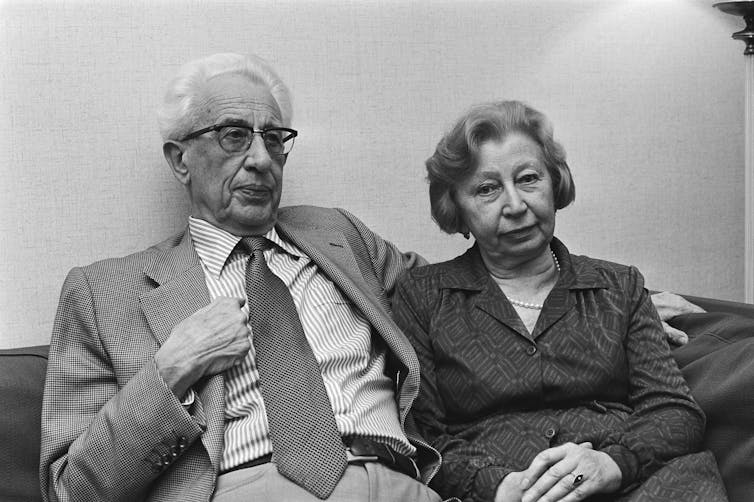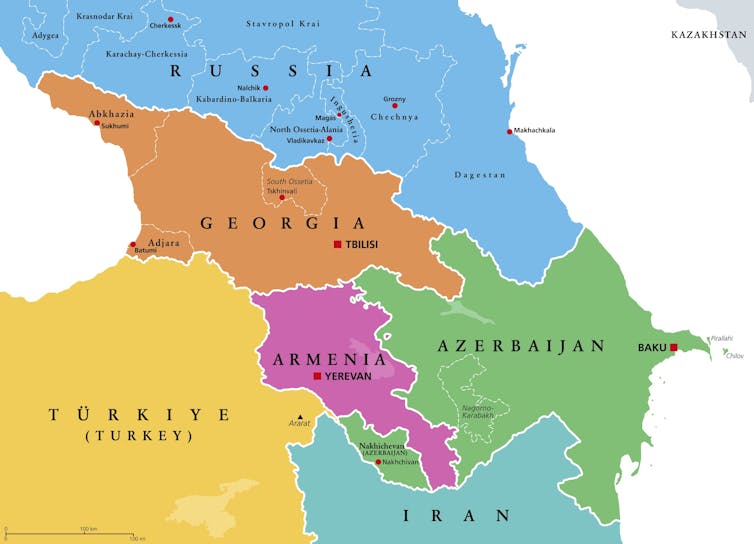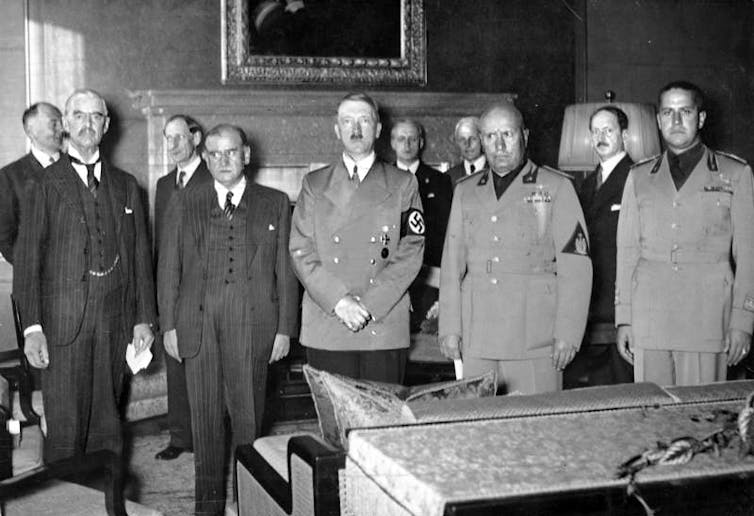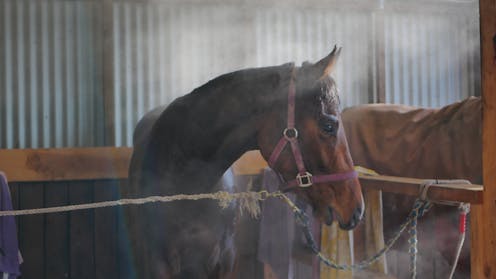Source: The Conversation – Global Perspectives – By Jan Lanicek, Associate Professor in Modern European History and Jewish History, UNSW Sydney

Everyone knows her photo. For some it shows the cheeky smile of a young girl, “Miss Quack Quack”. For others, the image represents an enigmatic veil of mystery, similar to Leonardo Da Vinci’s Mona Lisa.
Millions have read her diary, watched various renditions in theatres and on the screen, or visited exhibitions devoted to her story. Thousands queue in front of the house in Amsterdam, where she spent 760 days in the secret annex, hiding from the Gestapo and their Dutch collaborators.
People quote the most famous sentence from her diary, immortalised in the Hollywood film, saying that “in spite of everything I still believe that people are really good at heart”.
The sentence was written in July 1944 by 15-year-old Jewish girl Anne Frank, three weeks before the capture of her family by the Nazis. It represents the innocence, perhaps naivety of an adolescent, who after the war became one of the most iconic symbols of the Nazi Holocaust.
The quote carries a universal message that good will eventually prevail. This has turned Anne’s legacy into an easily adoptable trope, serving activists and political agendas. But who, actually, was Anne Frank? And how did she differ from the “Anne Franks” that have emerged since the end of the war?
The Many Lives of Anne Frank – Ruth Franklin (Yale University Press)
Acclaimed author Ruth Franklin explores these probing questions in her newest book. She is to be commended for her sensitive treatment of a difficult subject and an attempt to get as close as possible to Anne’s personality and nature.
Franklin follows two paths. First, she reconstructs Anne’s life based on the diary and recollections of people who knew her. In the second part, she reveals the afterlife of the diary and “Anne Frank”, in different contexts and on different platforms.
She concludes that the “Anne” most people know, or imagine, differs quite significantly from the girl who lived in the secret annex and penned the diary.
The story
Annelies Marie Frank was born in 1929 in Frankfurt am Main to an affluent assimilated German-Jewish family. After the rise of Hitler and the introduction of the first racial laws, her parents Otto and Edith decided to take Anne and her older sister Margot to the Netherlands. They continued to live in Amsterdam despite the growing threat, even after the German invasion in 1940. Attempts to emigrate to the United States failed.
The mounting persecution kept restricting their lives. In early 1942, the Nazis began to plan deportations of the Jews to the east. In July, when Margot received a call to the transport to occupied Poland, the family decided to go into hiding.

Photo collection Anne Frank House, Public domain, via Wikimedia Commons
They spent over two years in the secret annex, eventually accepting four more fugitives: the van Pels family, including their teenage son Peter, and dentist Fritz Pfeffer. They were supported by a group of people, including, most famously, Miep and Jan Gies.
The group, experiencing the constant tensions of living in the claustrophobic space, ran out of luck in early August 1944. They were betrayed, and the Nazis sent them to the transit camp of Westerbork, from where they continued on the very last train to Auschwitz. After a month, Margot and Anne were separated from their mother and sent to Bergen-Belsen in central Germany.
Their physical and mental state soon deteriorated. A survivor of Belsen later remembered the “two thin, shaven-headed figures” who “looked like freezing little birds”.
Shortly before the end of the war, typhus erupted in the overcrowded camp and Anne and Margot became its victims. Otto, liberated from Auschwitz, was the only survivor from the eight who hid in the secret annex.

Dutch National Archives, via Wikimedia Commons, CC BY
The diary
Anne got the red-checkered diary on her 13th birthday, shortly before moving to the secret annex. She wrote only occasionally, but soon the diary turned into her constant companion. It was a place where she could express her feelings.
Written in the form of letters to an imaginary friend Kitty (identified by Franklin as a character in Cissy van Marxveldt’s popular books for children), the diary offers a vivid reconstruction of life in hiding, describing in detail the daily routine. It also allowed Anne to vent frustration from constant conflicts with her mother, Mrs. van Pels and Pfeffer.
Another prominent feature, dominating later representations, was her evolving relationship with Peter, which eventually turned romantic.
In March 1944, Anne heard a radio broadcast by the exiled Dutch education minister Gerrit Bolkestein, who asked listeners to keep documentary evidence about their life under the Nazis. Anne began to rewrite her diary, now with the intention of making it public. Franklin suggests that this turned the book into a memoir in the form of diary entries.
Anne had not finished when the raid stopped her efforts. Not all parts of the diary survived. At least one of the original volumes, covering over a year, is missing; it does, however, exist in the version Anne wrote after March 1944.
Several versions
Otto returned to Amsterdam in June 1945. After they received a confirmation that Anne did not survive, Miep Gies handed over Anne’s papers, which she had found in the annex. Otto decided to publish the diary but, in what Franklin calls “the most confusing and contested” aspect of Anne’s story, “betrayed” her legacy.

Photo collection Anne Frank House, Public domain, via Wikimedia Commons
Otto combined both versions of the diary. He returned to the manuscript sections that Anne removed, including details of her romance with Peter. He softened the criticism of Anne’s mother and of Mr. and Mrs. van Pels.
Franklin believes Otto did so out of respect for victims. The last surviving pages from Anne’s diary, offering critical comments about her parents’ marriage, were made public only after Otto’s death decades later.
It took almost 40 years before a critical edition, comparing all the versions of the diary, was published by Dutch researchers. This necessarily raises the question of how far the Anne Frank people know from Otto’s version is different from Anne who lived in hiding and perished in Belsen.
Afterlife and projection
Despite initial scepticism, the diary immediately became a hit, especially in the United States. Soon there were efforts to turn it into a theatre play and film. Otto agreed, because he needed money to preserve the house with the annex.
The Broadway play premiered in 1955 and the Hollywood feature film in 1959. In the following decades, Anne’s story inspired scores of authors, but also activists who referred to the public icon in support of their agenda.
The immense publicity did not come without controversies. It has led, according to Franklin, to Anne becoming “whoever and whatever we need her to be”. Such efforts keep surfacing. Franklin is right to criticise those who deliberately aim to provoke, for example, by using Anne’s image in anti-Zionist campaigns.
The original theatre and film representations, according to some, intentionally universalised Anne’s story, suppressing her Jewish identity. This, according to Franklin, made the story more palatable to the American audience and reflected the American Jewish ideal at that time of full assimilation into American society.

Yet although Anne’s diary can speak to a multitude of audiences, it is a deeply Jewish story. Anne’s relation with her Jewish identity and Zionism was ambiguous, though she was aware of her background and wrote that they “will always remain Jews”. Margot, her sister, wanted to go to Mandatory Palestine as a maternity nurse; Otto in his later life was supportive of the Zionist project.
Another affair, more recently, focused on the parts of the diary where Anne expressed her desire to touch her female friend’s breast and kiss her. She also wrote about her attraction to female nudity in art.
There were accusations that Otto censored these parts of the diary, in an effort to deny the coming out of his daughter. This is unfair criticism. As Franklin shows, Otto included the entries, slightly modified, in the first US edition, even though Anne had removed them from the rewritten version of her diary.
Ironically, conservative circles in the United States have called for a ban of a graphic novel based on the book, calling it “Anne Frank pornography”. Franklin cautions us against such projections and reading too much into these comments. We simply don’t know enough about Anne and about how her sexuality would develop. In the diary, she repeatedly expressed attraction to several boys, including Peter van Pels.
The raid
These efforts only show how the popularised image of Anne keeps attracting attention. We still want to know more about her and solve all mysteries. In 2022, a Canadian author Rosemary Sullivan, in cooperation with a former FBI special agent, published a book that claimed to solve the mystery of Anne’s betrayal.
Until today, the culprit has not been identified. According to Sullivan, the Annex eight were betrayed by a member of the Dutch Jewish Council. This compulsory community body has often been accused of collaboration.
The publication triggered a quick response from Dutch Holocaust historians who, in a long rebuttal, rejected Sullivan’s claim, calling it a baseless fabrication. Dutch and German publishers withdrew the book.

Public domain, via Wikimedia Commons.
Who was the real Anne Frank?
The question ultimately remains unresolved.
Is it the girl who penned the first version of her diary to cope with the persecution and isolation in the annex? Is it the young woman, author of the second version, who matured too quickly because of a lack of contact with her peers? Is it the Anne that Otto, grieving after the loss of his whole family, reconstructed from the pages saved by Miep Gies?
Or is she one of the versions of her story produced at Broadway, Hollywood, by countless writers, and now even political activists?
We all suffer from cognitive dissonance. The only photos we have of Anne are those of a young girl from the time before the family went into hiding. But the Anne who wrote the diary was older, almost womanlike, physically and mentally. Miep Gies recalled that “she had arrived a girl, but she would leave a woman”.
Reading the diary, even though we know the end, we hope she will survive. We don’t want to know what happened after their capture. We don’t want to see her bald and emaciated in Auschwitz or Belsen.
At the same time, we know the story will end there. Franklin bitterly remarks that “readers already perceive Anne as if she were a figure in a book rather than a real person. To just about everyone, her life is of secondary importance to what we make of it.”
Perhaps we should just conclude, together with Franklin that Anne was a talented girl and “an accomplished and sophisticated writer – a deliberate, literary witness to Nazi persecution”. She had many virtues and vices.
She can inspire us, we need to learn about her, but we should respect her. We should not project onto her our current agenda, concerns or political views. We should “restore her as a human being”, and that’s exactly what Franklin does.
![]()
Jan Lanicek receives funding from the Australian Research Council and is co-president of the Australian Association for Jewish Studies.
– ref. Friday essay: who was Anne Frank? – https://theconversation.com/friday-essay-who-was-anne-frank-261748











